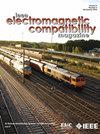Estimation of Reference Impedance in 2x-thru De-embedding With High Conductor-Loss Lines
IF 2
3区 计算机科学
Q3 ENGINEERING, ELECTRICAL & ELECTRONIC
IEEE Transactions on Electromagnetic Compatibility
Pub Date : 2024-09-11
DOI:10.1109/TEMC.2024.3445346
引用次数: 0
Abstract
The 2x-thru de-embedding has emerged as an attractive alternative to the classical TRL for高导体损耗线路 2x-thru 解嵌中的参考阻抗估算
在印刷电路板和封装设备的 S 参数测量中,2x-thru 去嵌入已成为传统 TRL 的一种极具吸引力的替代方法,这主要是由于它的简单性,即只需一个 THRU 标准就足以在宽带宽范围内全面鉴定测试装置。2x-thru 去嵌入后的 S 参数以 THRU 中传输线的特性阻抗为参考,准确估算该参考阻抗 (Zref) 对于后续的重正化和时域模拟非常重要。在 2x-thru 文献中,只报道过 Zref 的恒定估计值,大多基于时域反射仪 (TDR)。然而,传输线的特性阻抗与频率有关,而且对于高导体损耗的传输线,时域反射仪可能并不平坦。在本文中,我们通过分析表明 TDR 是一个随时间递增的函数,并提出了一种创新方法,通过用因果阻抗模型拟合 TDR 来估计 Zref。本文提供了仿真和测量实例,以验证所提出的理论和技术,并说明在 2x-thru 去嵌入中使用精确 Zref 进行重正化的重要性。
本文章由计算机程序翻译,如有差异,请以英文原文为准。
求助全文
约1分钟内获得全文
求助全文
来源期刊
CiteScore
4.80
自引率
19.00%
发文量
235
审稿时长
2.3 months
期刊介绍:
IEEE Transactions on Electromagnetic Compatibility publishes original and significant contributions related to all disciplines of electromagnetic compatibility (EMC) and relevant methods to predict, assess and prevent electromagnetic interference (EMI) and increase device/product immunity. The scope of the publication includes, but is not limited to Electromagnetic Environments; Interference Control; EMC and EMI Modeling; High Power Electromagnetics; EMC Standards, Methods of EMC Measurements; Computational Electromagnetics and Signal and Power Integrity, as applied or directly related to Electromagnetic Compatibility problems; Transmission Lines; Electrostatic Discharge and Lightning Effects; EMC in Wireless and Optical Technologies; EMC in Printed Circuit Board and System Design.

 求助内容:
求助内容: 应助结果提醒方式:
应助结果提醒方式:


